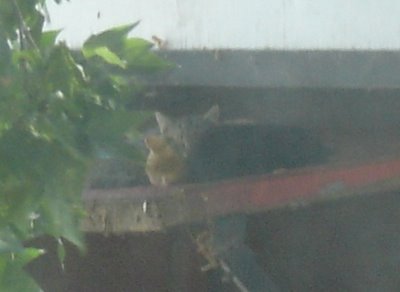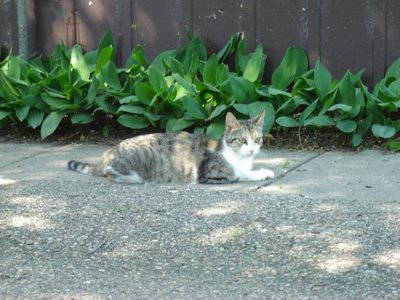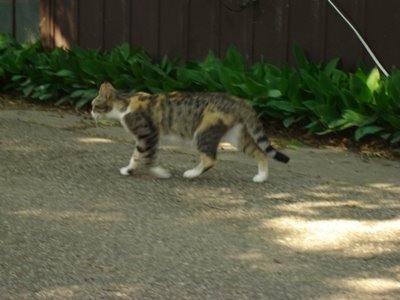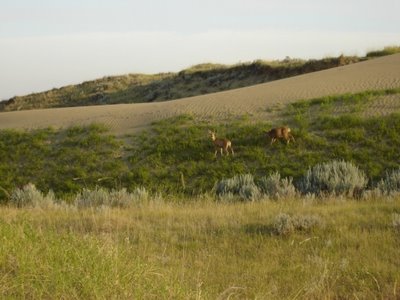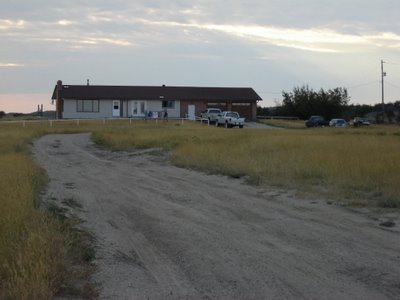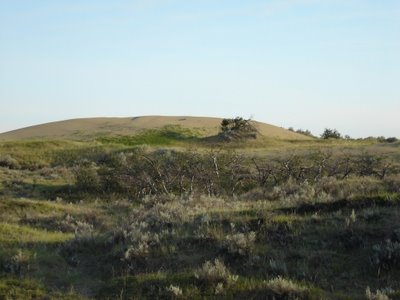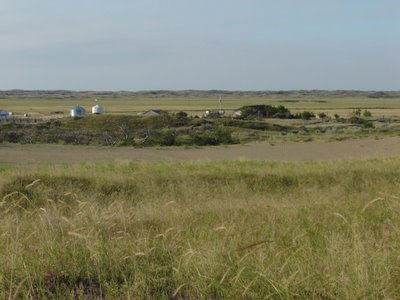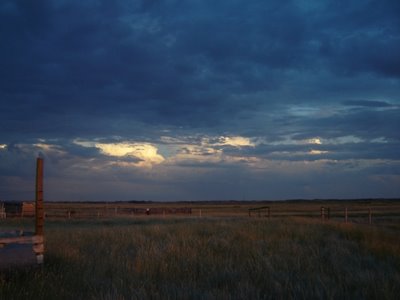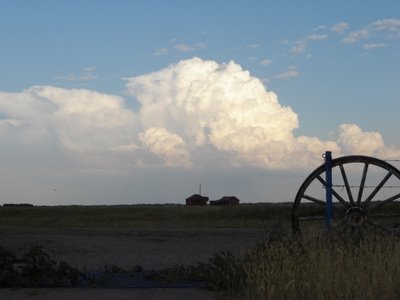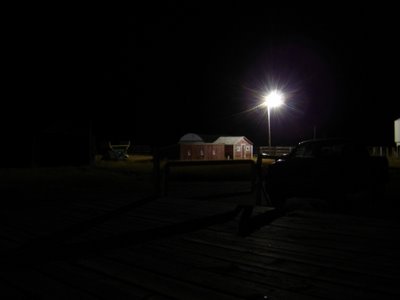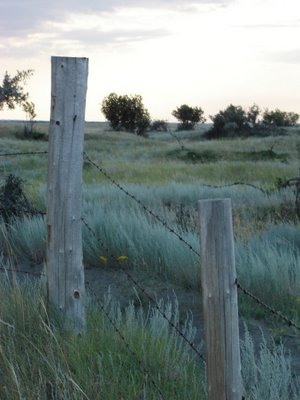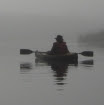Some people seem to look at the world through the lens of a team sport rivalry. To me, growing up without television or trips to the rink, team sports were something I looked at, not through; and I viewed them as a sometimes alarming curiosity. Now it occurs to me that perhaps others were so deeply involved and immersed in the world of sports that it became their window, their frame of reference when looking at the wider world beyond.
Take, for example, this post by Kate at Small Dead Animals. She asks, "Is Anyone Else Keeping Track?" Ah, the stats. Actually, I have wondered what the world would be like if people paid as much attention to the stats of nature observations as they did to the stats of baseball. But that's an aside. Here's the first part of Kate's post.
Drought, floods, severe winters, warm winters, more frequent storm activity, less frequent storm activity, early frost, early thaw, receding glaciers.Wait a moment. Who is doing the "citing"? Who is calling these events or observations "evidence"? Can you really use your "recollection as a news consumer" to summarise the activities and opinions of "climate research experts"? Kate goes on:
All have, to the best of my recollection as a news consumer, been cited by one climate research expert or another as evidence of "global warming".
The same experts will also quickly caution that even in the midst of dramatic climate change, one should expect periods of "average" rainfall, temperature, storm activity."The same experts"? Try substituting "journalists" for "experts." I don't think you would hear an expert talking about expecting average conditions. Instead, they might talk about conditions being in constant fluctuation, swinging widely above and below an average that is creeping almost imperceptibly. Who can remember whether winters were colder back in one's childhood, or whether they just didn't make boots quite as warm back then? Or whether it felt colder because we had to stand outside more when we were kids, waiting for the school bus? I remember a bitter December cold spell in the late '80's, but of course I don't remember what that winter's average was like. I remember Dad working outside in his shirtsleeves in February some years earlier than that, too. But those are just fluctuations. What the averages were, I couldn't possibly begin to guess. And then, to guess at averages around the globe? Absolutely out of the question. Or to try to compare a grandparent's recollections with my own? Pointless. They say they walked ten miles to school every day, and ten miles home again, and it was uphill both ways.
We remember (and embellish) the extremes, the unusual. We remark on the remarkable. The average is forgettable. In fact, our brains function by tuning out the background and saving perceptive and processing power for anything new and different.
Most of what we see in the news being linked to global warming is not what the experts would call "evidence." In fact, in much of their writing, experts don't mention "evidence" at all. They talk about observations, and whether these observations are in accord with what is expected based on a current hypothesis about climate systems, or whether these observations indicate that a hypothesis should be rejected.
When discussing the significance of their findings, experts may talk about how it fits within a body of scientific evidence that supports the current understanding of climate systems. However, there is an important difference here from the way Kate seems to be talking about evidence.
In science, as in law, evidence is not simply piled up on one side or the other, to see which side has the most. "Weight of evidence" is an important legal concept, but there is also the matter of building a case. The pieces of evidence have to fit together to create a meaningful whole.
I suspect that a great deal of popular confusion about science could result from the influence of sports on popular thinking. In sports, it is all about keeping score for each side. A goal is evidence of a team's prowess. Pile up enough goals in the time allotted, while preventing goals by the other side, and your team is declared the winner.
Now that I think about it, much of our society's function is organized along similar lines. From town hall meetings to board rooms to the House of Commons, decisions are finalized by counting up votes for or against. Opinion polls shape policies before they are brought to official votes. Consumers are encouraged to notice how they are voting with their dollars.
Science works quite differently. It is not simply a matter of counting up observations for or against a certain understanding. A single conflicting observation can bring down or "falsify" a hypothesis. Of course, there will be checking and double-checking to find out whether there was something false about that one observation, but if it holds, then the hypothesis does not. A new hypothesis might bear considerable resemblance to the old, rejected hypothesis, but it will take into account the new observation. Contrast sports, where it doesn't matter how well executed a particular goal was; if it wasn't made by the winning team, it doesn't carry the same weight.
Now, getting back to Kate's list. Most of the phenomena that she mentioned are discussed by some experts, but not as evidence of global warming. Instead they are predicted as outcomes of global warming. If they fail to appear, or if different outcomes appear, then it is the predictive models that are shown to be lacking. That doesn't mean that evidence has been struck down; it wasn't evidence in the first place.
A couple of the phenomena that Kate listed come close to the kind of observations that climate researchers would consider when questioning whether global temperatures are increasing as expected, or not. Winters would be considered, not in terms of this or that winter being "severe" or "warm," but in terms of average winter temperatures trending colder or warmer. Early thaw has been observed as a long-term trend in western Canada, based not only on temperatures but also on indirect observations, such as dates of peak runoff volumes, and flowering dates of poplar trees at Edmonton (which have moved nearly a month earlier over the course of a century). Indirect observations like these may help to compensate for problems in instrumental records of surface temperatures, by reflecting the ongoing influence of temperature over large areas of the landscape instead of just snapshots of exact temperature at single locations and times. However, they are still vulnerable to problems; for example, the shift in flowering dates for poplars in Edmonton may be partly due to the same urban-heat-island effect that affects parts of the instrumental record. In their 2002 article (pdf) about the shift in flowering dates, Beaubien and Freeland discuss this problem and provide some comparative information about temperatures within and outside Edmonton.
That gives you a glimpse into the way science works. These researchers are not just piling up points to win the argument. They are trying to give as much relevant information as they can, to let others continue the investigation and refine understanding in the problem areas.
Once again, let's return to Kate's post, and the final phenomenon on her list, "receding glaciers." Glacier length has been used as a proxy when estimating past temperature regimes. It has the advantage of slow change, which means that it provides a built-in averaging of the temperatures affecting the glacier. However, it is greatly complicated by the influence of changes in precipitation, and may also be influenced by other factors such as dust absorbing solar radiation and heating the glacier surface, tectonic activity, ice within the glacier crossing threshholds of density and fluidity, and so on. Again, averaging is important when interpreting glacier length, to control for some of these other factors by averaging across a large number of glaciers.
But Kate gleefully seizes on a report about a specific subset of glaciers (western Himalayan) as the final item to complete her list of contradictions in the "evidence of 'global warming'."
With today's addition of expanding glaciers, the list is finally complete. It's therefore, official - climate change proponants have taken ownership of virtually every local and global weather phenomenon worthy of newspaper ink, including "average"."Climate change proponents" - I like that. As if these researchers are hoping for a big, bad change.
One would think that more people would have noticed.
What I see in this news story (and what I see more clearly when I seek out its source, a press releasefrom Newcastle University) is diligence by researchers exploring an observation that appears to be in conflict with current understandings. What Kate sees is just one more example of dishonest politically or financially motivated researchers attempting to contort any and all changes in weather or climate, regardless of their direction, into evidence of global warming. (This might not be obvious by reading her post in isolation, but in the context of her climate-related posts over the last couple of years, her subtext is plain to see. In this case, I would assume that Kate suspects these "climate change proponents" of attempting proactive damage control, coming up with a way to explain glacier expansion as an effect of global warming before somebody else observes the same glacier expansion and calls it evidence of global cooling.)
Now, let's look more closely at the press release. It mentions the title of the forthcoming journal article: "Conflicting signal of climatic change in the Upper Indus Basin." Hardly sounds like these researchers are trumpeting their goal scored in support of a global warming win. Sure, Kate can interpret it as a sly move to protect their cherished theory from conflicting evidence, if she wants. But from my perspective, it sounds very different. It sounds like these researchers are not going to join in on any simplistic fearful chorus about everything heating up; instead they're doing their best to clarify what they actually are seeing in climate trends.
Perhaps more importantly, I notice that a large part of the press release (and a significant part of the news item Kate linked) are concerned with the implications of these trends for water supplies for 50 million people in Pakistan. Whenever someone argues persistently with Kate about climate change, she falls back to her argument that resources should be used for adaptation, not for trying to prevent it. Here is a team of researchers working towards a sound method of predicting future runoff volumes into reservoirs, as the climate changes. What a fine contribution to the ability of those 50 million people to adapt - and Kate is bashing the news in order to score a point with her readers.
Sometimes I wonder whether perhaps a lot of bloggers who present themselves as climate change skeptics actually understand the science just fine. Perhaps they have their motives for wanting to see business as usual and adaptation only after the consequences are upon us - and they're willing to use ignorance among their readers as the means to that end. It could be a powerful modus operandi. You see, in the court of public opinion, it doesn't really matter whether the pieces of evidence fit within a meaningful whole, or even whether they are valid. Incorrect evidence works just fine, as long as it scores a point with some people, and as long as a later correction doesn't get too much attention. It's like the goalie knocking the puck into his own net; a total mistake still counts as a goal.
And then there's a goal scored by breaking the rules. As long as a ref doesn't notice, that goal still counts.
Of course, in blogging, even if the ref does call a foul, most of your readers won't notice. You can even publish the correction right there as an update to the offending post, and you won't suffer much of a penalty. Your readers will have moved on to your more recent posts. And the final score of the game is never published anyway. So what counts? Anytime you can get that puck in the net, no matter how you do it. That's what counts.
Of course, you have to balance that with the danger of losing readers. If there's nobody in the rink to see the goal, then it doesn't count after all.
But I don't see much sign of these skeptics losing readers.

